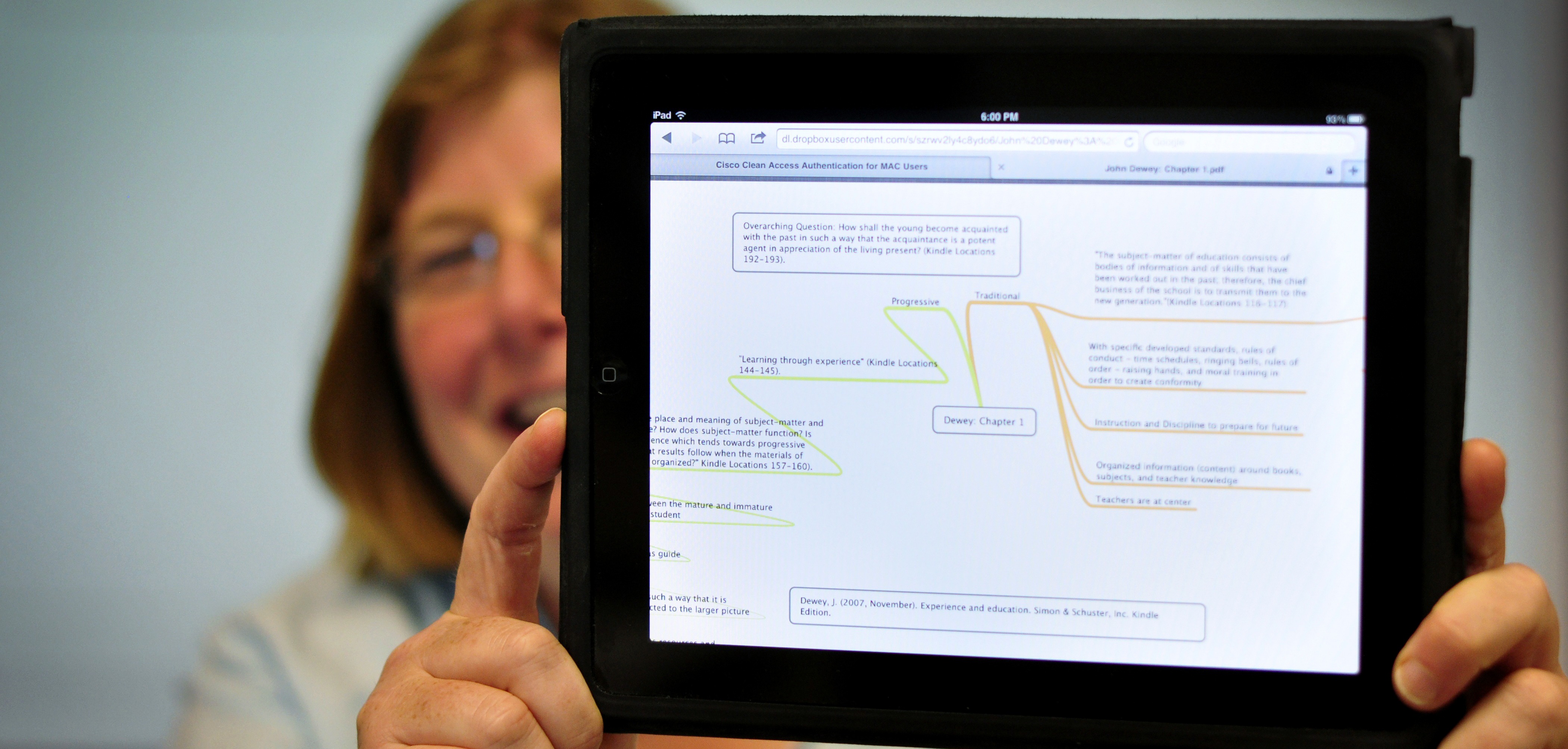Education professors host 5th annual EdTech Conference
4 min read
University of Mary Washington
By HANNAH RIDDLE
Room 122 in the Stafford Campus’ North Building was filled with sounds of humming and beeping. Inside, a 3D printer scooted back and forth, slowly feeding on strings of blue plastic. On the table nearby, a WaterColor Bot mechanically moved its paintbrush, creating an exact replica of a picture on the laptop beside it.
Moving around the room, checking on other gadgets and fiddling with Little Bits Electronics was George Meadows, an education professor at the University of Mary Washington. Helping him were three of his students, Michelle Michniak, Emily Nykorchuk and Harrison Miles.
These four were running the Learner Space Demonstration, a hands-on exhibit offered at the fifth annual EdTech Conference. The event was hosted by UMW last Friday at the Stafford Campus.
Over 160 teachers and principals from northern Virginia schools attended the all-day conference. Through lectures, workshops and presentations, attendees learned about ways to bring innovative teaching and technology into their classrooms.
Among the attendees was Kathy Notyce, a principal from Prince William County. Curious to see what new technology was available for her students, Notyce visited the Learner Space Demonstration in the late afternoon.
Meadows greeted her and swept a hand at his college students.
“There’s your future employees,” said Meadows.
The UMW students then showed Notyce around the Leaner Space, after which the principal wrote down their names and told them to visit her any time.
This was a welcome invitation for Michniak, Nykorchuk and Miles, all of whom are senior members of the College of Education and will soon be looking for job opportunities in public schools.
Currently, they are looking forward to beginning their master’s work in the fall, as they study to become licensed teachers. Under the supervision of Meadows, they will complete specialized research in the areas of science and technology.
“I really enjoy technology, and I would like to see more of it in schools,” said Miles as he hooked a robot up to a laptop. “Students should be tech-literate for the modern world.”
Nykorchuk agreed, saying that she thinks technology can also be used as a classroom tool to excite learners.
“My focus is going to be using technology to teach math in more interesting ways,” said Nykorchuck.
Teresea Coffman, UMW professor of education, planned and organized this year’s EdTech Conference along with her colleague, assistant professor of education Tami Pratt-Fartro. Coffman said she hoped that the event would encourage educators who think along the same lines as UMW students.
“You just want this experience to validate us as teachers,” said Coffman, who explained how important it is to provide space and time for discussions about the integration of education and technology.
Coffman was particularly excited about one of the conference’s morning sessions that featured 80 third, fourth and fifth graders from Alvey Elementary School and Haymarket Elementary Schools.
The session, entitled “Solving the Mystery of STEM! IT’s Elementary, My Dear!,” gave the students an opportunity to share and answer questions about animations they had created using a Tech4Learning program.
“The elementary school students and the teachers, they were just beaming,” said Coffman. “And their parents were here, and they were beaming. And you’re like, okay, this is why we do it.”
UMW alumna Alex Jaffee, led another one of the conference’s sessions.
Jaffee graduated in 2013 from the master’s in education program, in which she specialized in technology under Meadows. She is now in her third year of teaching at Porter Traditional School.
During her session, titled “You’re Off to Great Places at the Integration Station!,” Jaffee presented on how she integrates technology into the day-to-day schedule of her second grade students.
Jaffee shared how her class used the Flipagram app to create movie trailers about erosion and the Google Maps program to practice addition skills.
Her students also use a Facebook-like website called Emodo during literacy stations.
“It offers flexible grouping, it gives students immediate feedback, and you can differentiate,” she told her audience, explaining how the new technology makes her teaching more effective.
Among Jaffee’s audience was Sandy Armstrong, a retired special education teacher who still volunteers in Prince William County Schools.
“She was fabulous,” said Armstrong of Jafee after the presentation. “Some of these websites she gave us, some of these apps, I intend to take back and share with the county because I know we’re not using all of them.”
Other highlights of the conference included keynote speaker Judi Harris, a professor from the College of William & Mary, and a presentation on game-based curriculum design by UMW faculty members Mary Kayler and Lisa Ames.
During the latter session, conference-goers were introduced to beginning aspects of game design by breaking into groups and creating board games based on popular children’s books.
Kayler argued that game technology motivates students to become involved in their own learning process.
“It’s a way to shift dynamics in the class,” said Kayler. “Students now become active.”











